Key takeaways:
- Surveillance ethics balances issues of privacy, consent, and security, reflecting on personal experiences with technology and data collection.
- Historical contexts reveal the evolution of surveillance and its impact on personal freedoms, raising awareness of its implications in modern society.
- Key principles for ethical surveillance include transparency, accountability, and proportionality, which are essential for building trust and safeguarding privacy.
- Case studies, such as Cambridge Analytica and facial recognition technology, highlight the ethical dilemmas of data usage and the potential for misuse.
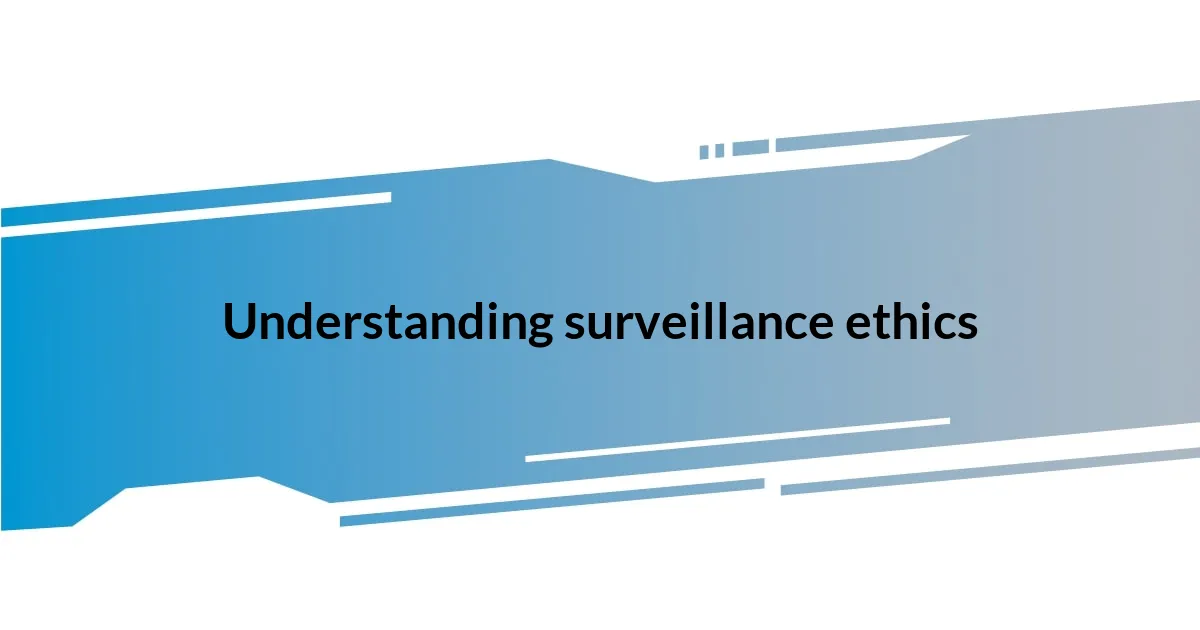
Understanding surveillance ethics
Surveillance ethics is a fascinating field that grapples with an array of questions surrounding privacy, consent, and the implications of monitoring individuals. I often wonder: at what point does the pursuit of security infringe on our fundamental rights? When I think about my own experiences with surveillance, like using the GPS on my phone that tracks my movements, it strikes me as a delicate balancing act between convenience and privacy.
Day-to-day, we’re bombarded with technology that collects our data, whether it’s online shopping or social media interactions. Reflecting on my experiences, I recall a time when a targeted ad made me uncomfortable because it felt too personal. This incident made me consider: are we really aware of how much we’re being watched and what that means for our autonomy as individuals?
The ethical landscape is filled with gray areas. I remember discussing the topic with friends, and one posed a compelling idea: if surveillance can prevent harm, does that justify its existence? This thought lingers with me. I find myself cycling back to it, recognizing that the answers are often more complex than I initially assumed.
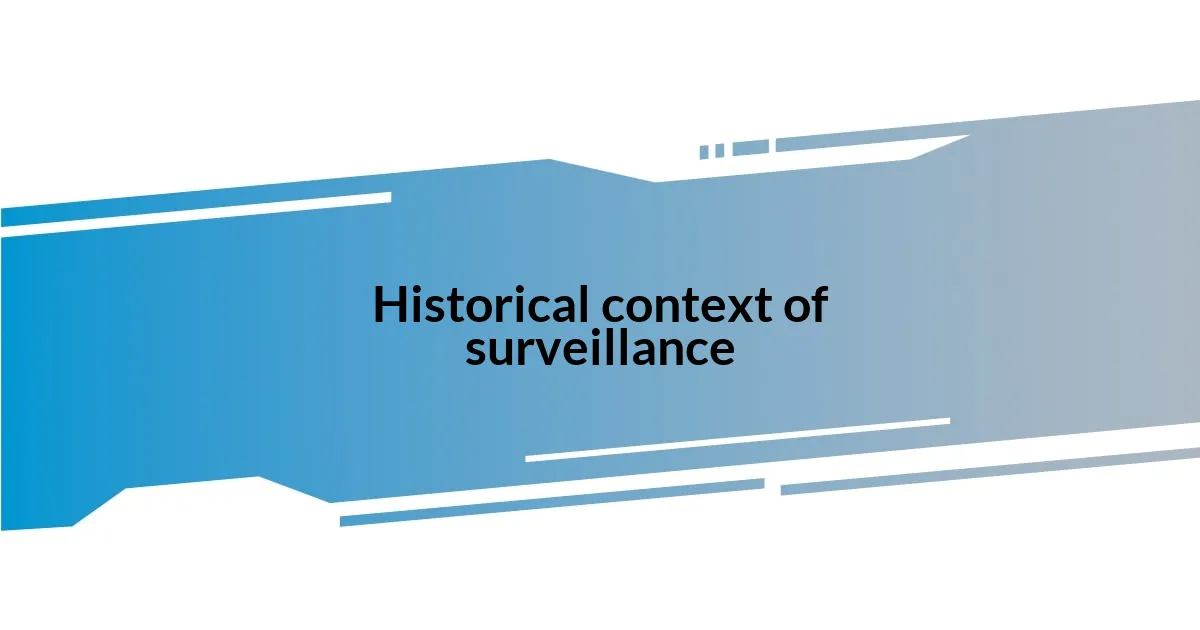
Historical context of surveillance
Throughout history, the concept of surveillance has evolved dramatically, influenced by technological advancements and societal changes. I distinctly remember a documentary I watched about the Stasi in East Germany; it revealed how an extensive network of informants created a culture of fear and mistrust. This historical example shaped my view on the immense power surveillance can wield, often at the expense of personal freedoms.
- Ancient civilizations used various forms of surveillance, from spies to watchtowers.
- In the 20th century, totalitarian regimes, like the Gestapo in Nazi Germany, employed systemic surveillance for oppressive control.
- The advent of the internet in the late 20th century introduced new dimensions of data collection and monitoring.
- Dialogues around personal privacy intensified in the early 2000s with incidents like the September 11 attacks, leading to expanded government surveillance in the name of national security.
Reflecting on these shifts, I can’t help but think how much more aware we need to be about surveillance today. Each example in history feels like a cautionary tale—reminding me that while technology may enhance our lives, it also demands we carefully consider the price of our convenience.
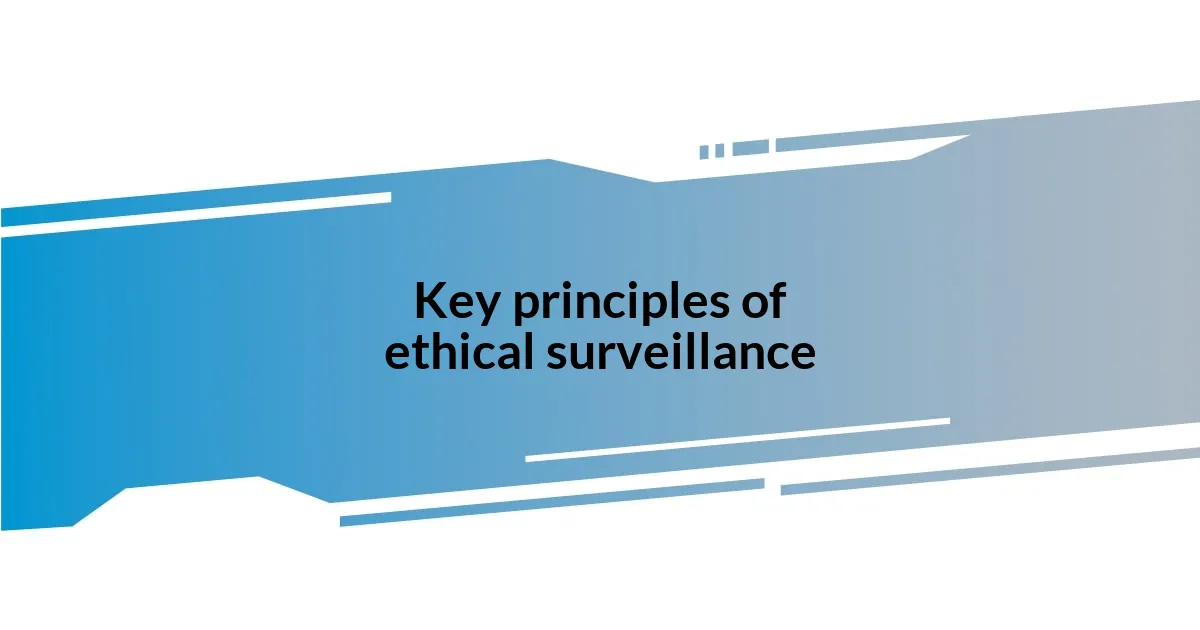
Key principles of ethical surveillance
The key principles of ethical surveillance revolve around transparency, accountability, and respect for individuals’ privacy. I often reflect on my experiences with technology that tracks my behavior. For instance, every time I accept a cookie policy on a website, I wonder if I’m truly informed about what I’m agreeing to. This highlights the importance of being transparent—organizations must clearly communicate how surveillance is conducted and the purpose behind it, fostering trust between them and individuals.
Accountability is another essential element. Companies and governments need to have checks and balances in place, ensuring their surveillance practices are justified. I remember a recent incident involving a data breach that exposed sensitive information. This event left me feeling vulnerable and questioning whether the entities that surveil us are held to high standards. Establishing clear consequences for misuse can help protect people from exploitation.
Finally, the principle of proportionate use emphasizes that surveillance should only be employed when necessary and in a manner that limits its scope. I recall a moment when a simple app wanted access to my location data for a service I didn’t think warranted such information. That experience made me realize that ethical surveillance should always be about striking the right balance between safety and personal freedoms. After all, isn’t it our right to choose what part of our lives remains private?
| Principle | Description |
|---|---|
| Transparency | Organizations must inform individuals about their surveillance practices. |
| Accountability | There should be checks and balances to ensure responsible use of surveillance. |
| Proportionality | Surveillance should only be conducted when necessary and limited in scope. |
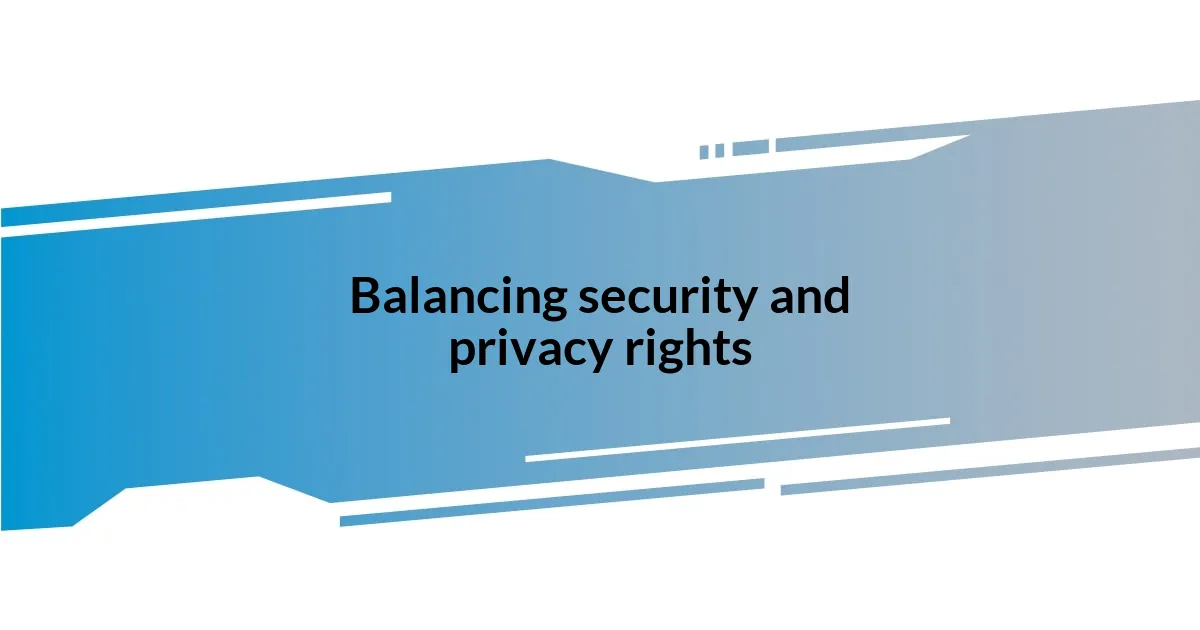
Balancing security and privacy rights
Finding the right balance between security and privacy rights feels like walking a tightrope. I remember the aftermath of a safety scare in my neighborhood, where people welcomed increased surveillance measures for peace of mind. But it made me question: at what point does that safety start to infringe on our freedoms? It’s a delicate dance where the scales can tip far too easily.
There are moments when I feel a nagging unease about the data I leave behind. For instance, last summer, I boarded a flight and found my phone buzzing with travel updates triggered by location tracking. Sure, it was convenient, but I couldn’t shake the feeling that there’s an unseen cost to such ease. It leaves me pondering whether the strides in security genuinely serve us or if we’re simply trading our privacy for a false sense of safety.
Navigating this issue also means considering the implications of surveillance in everyday life. When I can’t go a day without ads targeting my interests based on my online behavior, I can’t help but feel that my personal space is shrinking. How can we protect ourselves from overreach while still embracing safety? This balance is an ongoing conversation that each of us must engage in, as it shapes our relationship with both technology and authority.
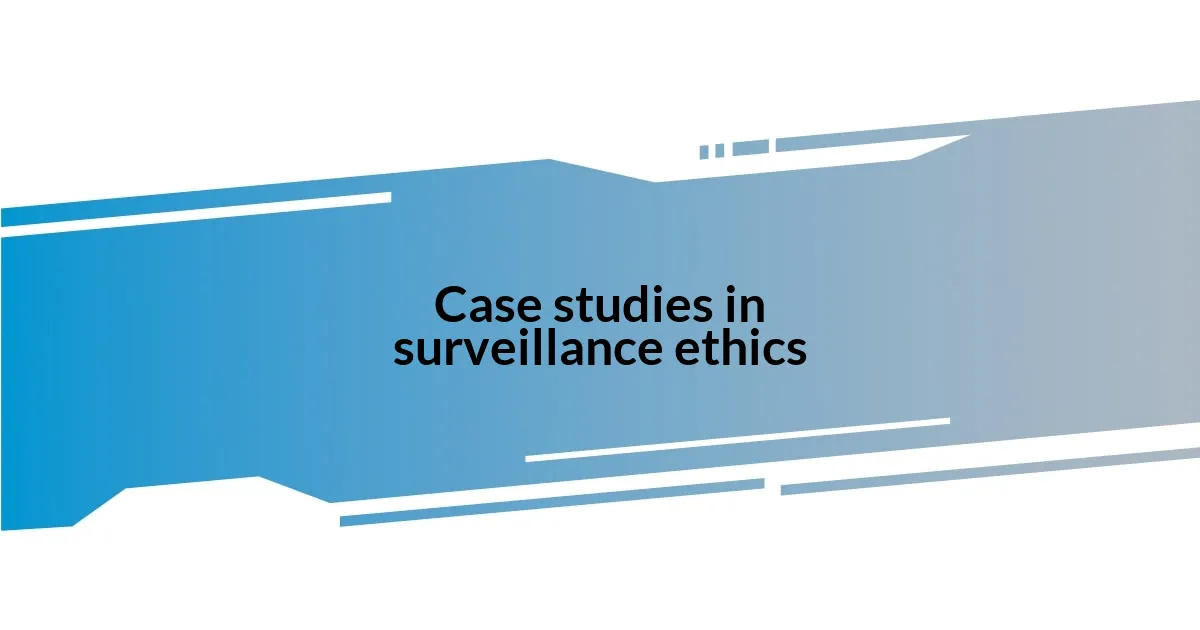
Case studies in surveillance ethics
Exploring case studies in surveillance ethics reveals stark realities about our digital lives. I recently came across the story of Cambridge Analytica, where users’ personal information was harvested without consent for targeted political advertising. This incident left me feeling uneasy; it made me reconsider how much we trust tech companies to handle our data responsibly. If someone’s data can be used to influence a political election, where does that leave our autonomy?
Another eye-opening case is the use of facial recognition technology in public spaces. In one instance, a city implemented this technology with the intention of enhancing security, only to find itself embroiled in a controversy over racial profiling. Reflecting on this, I can’t help but think: are we sacrificing justice for security? The emotional weight of knowing that surveillance could unjustly target individuals based on their appearance challenges the narrative that technology is inherently neutral.
Further, I can’t shake the memory of a friend who felt violated when receiving unsolicited ads for products he had only discussed in private. This sparked a heated conversation about how algorithmic surveillance crosses into the realm of our intimate lives. Shouldn’t we have control over what is monitored, especially in spaces that feel personal? These examples illustrate the complex web of ethics surrounding surveillance, pushing us to question who truly benefits when surveillance measures are enacted.
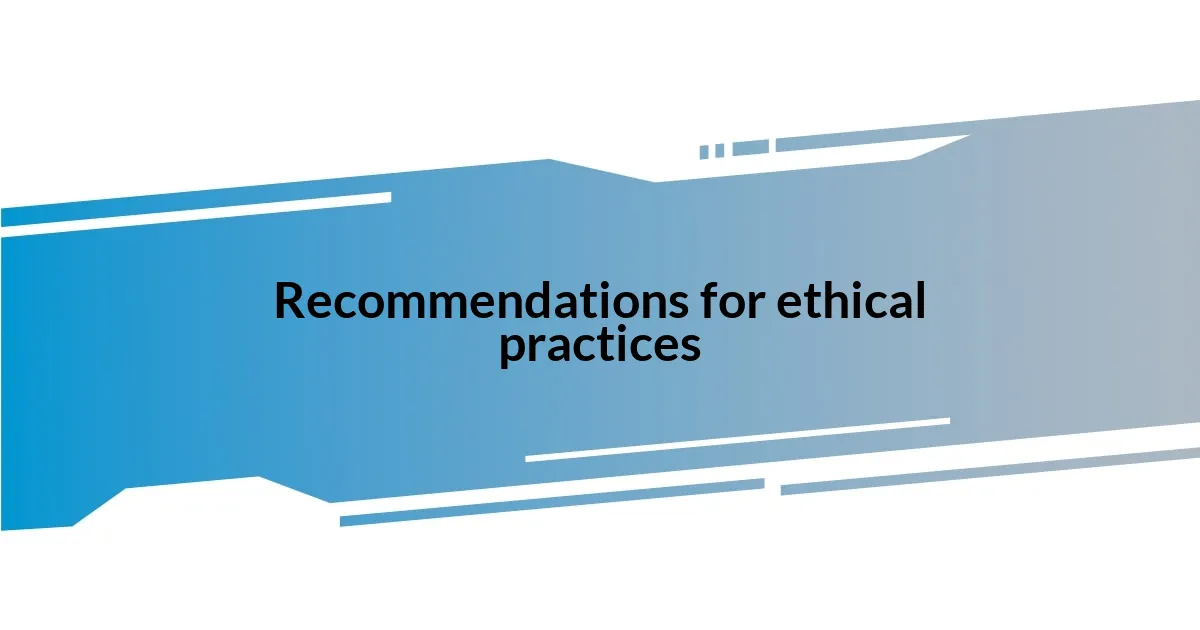
Recommendations for ethical practices
When considering ethical practices in surveillance, transparency must take center stage. I once participated in a town hall meeting where local law enforcement shared their plans for installing new cameras. Their willingness to answer questions was refreshing; yet, I still felt an underlying tension. Should there be an assurance that this data will not be misused or kept indefinitely? It’s essential for organizations to openly communicate their policies regarding data collection and usage to build trust with the communities they serve.
Moreover, I feel strongly that consent should be prioritized in any surveillance effort. I remember using a fitness app that requested access to my location even when it didn’t seem relevant to the service. It left me wondering how often users unknowingly grant permission for invasive tracking. Implementing clearer consent processes would empower individuals to make informed choices about their data, fostering a sense of autonomy amid a sea of technology that often feels overwhelming.
Lastly, I can’t emphasize enough the importance of regular audits and accountability measures. In my experience, knowing that an independent body reviews surveillance practices can provide a layer of reassurance. We’ve seen trends where certain technologies slip through the cracks, leading to misuse. Regular checks not only safeguard privacy but also encourage organizations to hold themselves to higher ethical standards. How can we ensure responsible practices without oversight? It’s an important question that deserves serious attention as our digital landscape evolves.